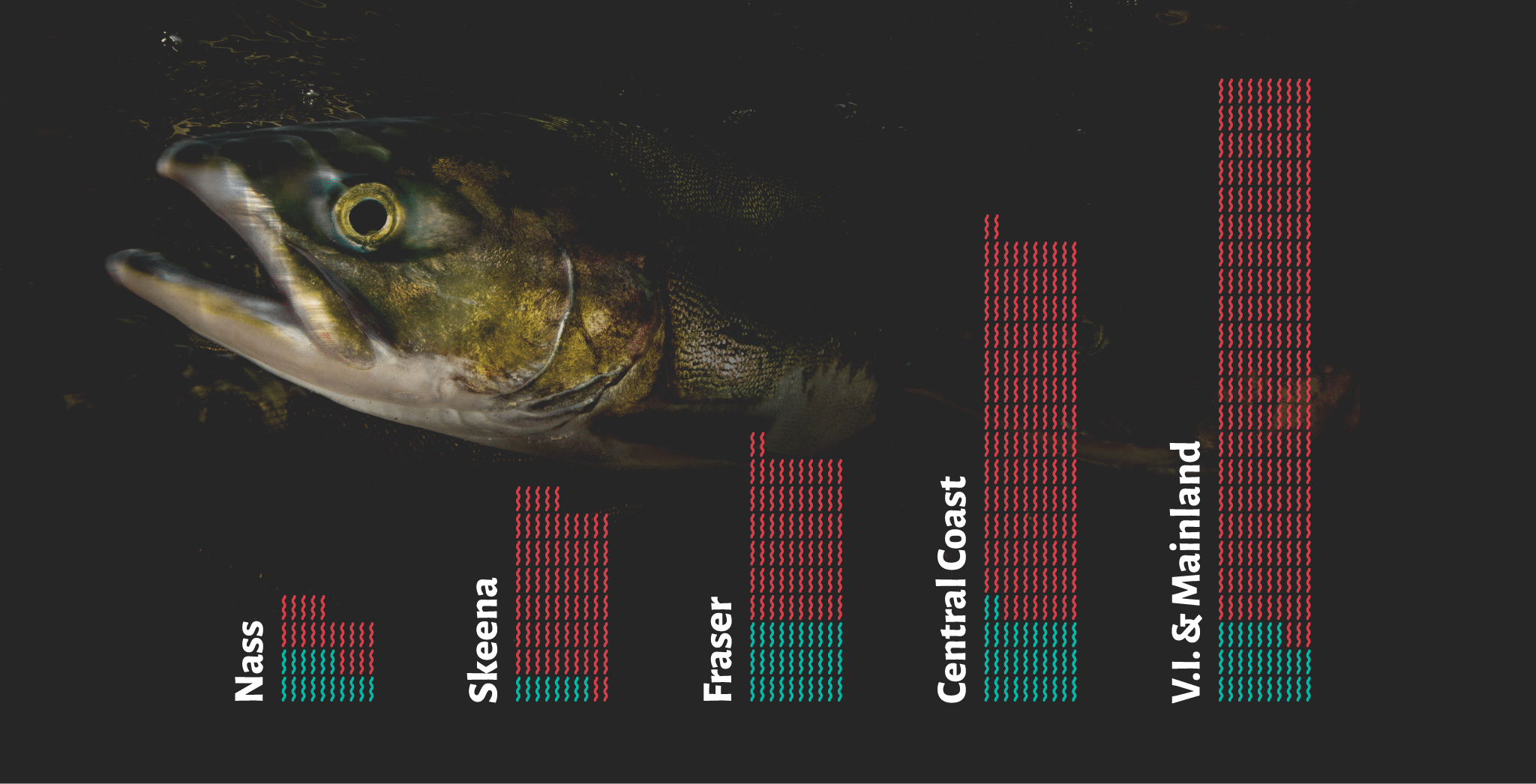Pacific Wild recently completed an in-depth analysis of salmon enumeration data, compiled from the Pacific Salmon Foundation Salmon Explorer and DFO New Escapement Salmon Database. This research determined how many salmon spawning streams are monitored and counted on a yearly basis and identified voids in data collection.
"There are massive gaps in the data collected and used to inform management decisions. Populations continue to decline at such rapid rates with the health of our entire ecosystems hanging in the balance. How can we have a true understanding of salmon status or health?”
— Emmie Page, Pacific Wild Marine Campaigner

Data Sufficient vs. Data Deficient* Salmon Spawn Streams in the Five Major Management Regions of B.C.
*Streams that have not been enumerated since 2018 or prior. Source: www.salmonexplorer.ca
81% of Central Coast spawning streams have had no data collection since 2018 or prior.
Source: www.salmonexplorer.ca

Fisheries and Oceans Canada (DFO) continues to use stock assessment models that rely on data from only a small number of indicator streams meant to represent entire stocks. We have seen consistent population declines — it’s now essential that we have a full picture of salmon populations and no longer acceptable for DFO to cut corners in management. To learn more about the management of salmon, read our blog Blind Management, Uncounted Rivers.
While DFO does acknowledge that proper management of salmon requires consistent monitoring and ongoing updates to models, the use of indicator streams as the main data source is not realistic or reliable when entire species are struggling. In many streams, frequency and quality of data collection is an issue, with some streams going decades without being monitored at all. 80% of salmon spawning streams province-wide are data-deficient and have not been enumerated since at least 2018. On the Central Coast, 81% of spawning streams have had no data collection since 2018 or prior. 29 Conservation Units of salmon have no public data record. More remote stream systems are more frequently being passed over for official enumeration and yet continue to see the lowest returns on record. In DFO’s own 2021 Integrated Fisheries Management Plan for salmon, many stock management units are listed as ‘data deficient’ — having poor assessment quality and infrequent data collection. Read more about the history of salmon enumeration in Counting is Key.
Only 2%* of the new B.C. Salmon Restoration and Innovation Fund is supporting projects in the Central Coast.
DFO needs to take the initiative to fund and develop infrastructure in this remote region to allow for the necessary monitoring of salmon streams.
*36% of the funding is broadly spread across coastwide projects.
$19 million of the Salmon Restoration and Innovation Fund is going towards aquaculture projects.
While not all projects are related to salmon farming, this still comes despite widespread concern about the negative impacts salmon farms have on the environment and wild populations.
Indigenous Nations Guardians and charter patrolmen are exceptional stewards and monitors on the Central and North Coast, yet are underutilized in the fight to protect wild salmon. After the 2021 election, $340 million over five years was pledged to supporting Indigneous-led conservation programs across all conservation programs, including salmon escapement monitoring. These programs have the potential to fill the gaps in population information and bring a more robust data set into management models. However, even previous data collected by the few Guardians and charter patrolmen have not always been used in federal population studies.
Salmon populations continue to decline and DFO doesn’t have a full picture of population health. The gaps are obvious — there needs to be a better process to integrate Indigenous Guardian Program data into DFO management models, fund monitoring for specific streams that are data deficient, and to have this data made publicly available. Ensuring enumeration of all streams is imperative in the wild salmon conservation effort.
more challenges faced by salmon
Salmon are now facing unprecedented challenges, especially considering the extreme flooding events in British Columbia (B.C.) in November 2021, which have resulted in devastating impacts for salmon. High water levels have created even more risk to already struggling salmon populations. With increased erosion comes increased water turbidity and strong currents, making it difficult for fish to navigate rivers. The summer also saw extreme heat waves and drought conditions hit B.C.’s coast. Pacific salmon are cold water fish and the impact of warm water and low stream volume makes it near impossible for fish to complete their upstream migrations. These are just some of the more recent challenges that salmon face, alongside deforestation from wildfires, parasitic diseases introduced from fish farms, and industrial development along shorelines.

